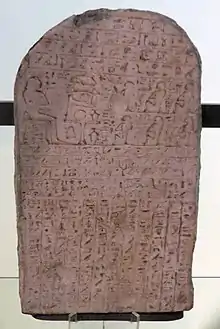Sebek-khu Stele
The Sebek-khu Stele, also known as the Stele of Khu-sobek, is an inscription in honour of a man named Sebek-khu (Khu-sobek), who lived during the reign of Senusret III (reign: 1878 – 1839 BC) discovered by John Garstang in 1901[1] outside Khu-sobek's tomb at Abydos, Egypt, and now housed in the Manchester Museum.[2][3]
| Sebek-khu Stele | |
|---|---|
 The Sebek-khu Stele in a 1914 Manchester Museum brochure | |
| Material | Limestone |
| Writing | Ancient Egyptian hieroglyphs |
| Created | c.1880-1840 BC |
| Discovered | 1901 Abydos, Egypt |
| Discovered by | John Garstang |
| Present location | Manchester Museum |
| Identification | 3306 |
The text is largely about Khu-sobek's life, and is historically important because it records the earliest known Egyptian military campaign in Canaan (or elsewhere in Asia). The text reads "His Majesty proceeded northward to overthrow the Asiatics. His Majesty reached a foreign country of which the name was Sekmem (...) Then Sekmem fell, together with the wretched Retenu", where Sekmem (s-k-m-m) is thought to be Shechem.[4]
References
- The Stela of Khu-Sobek (Manchester Museum)
- Manchester Museum: 3306 Stela, Object, Registered, Africa, Egypt, Upper Egypt, Abydos
- The Land of the Bible: A Historical Geography, Yohanan Aharoni
- Pritchard, James B. (2016). Ancient Near Eastern Texts Relating to the Old Testament with Supplement. Princeton University Press. p. 230. ISBN 978-1-4008-8276-2.
This article is issued from Wikipedia. The text is licensed under Creative Commons - Attribution - Sharealike. Additional terms may apply for the media files.
